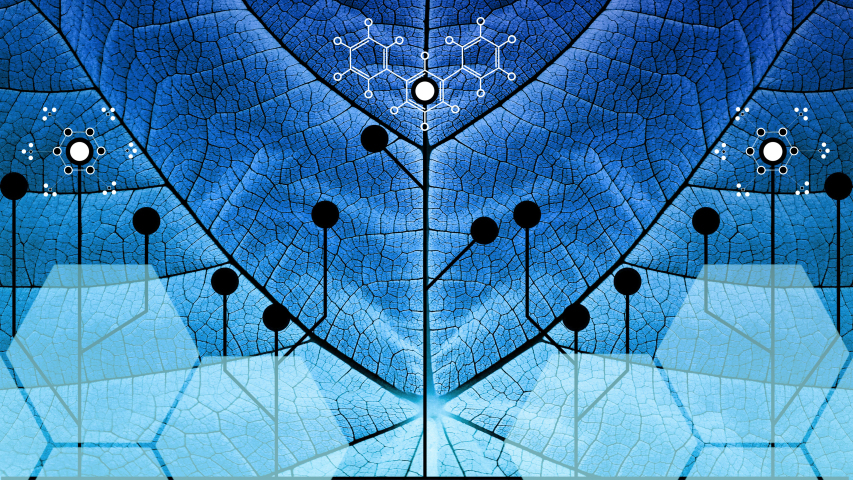
Polymers dive into the heart of materials
Plastics will find a use for anything
As we all know, wood is one of the oldest materials used by mankind. Even today, it is far from obsolete and still has applications in many industries such as the construction industry, where it is almost indispensable for manufacturing frames for single-family homes. In the age of high-tech materials, wood is still used in this field, although not for aesthetic reasons as a house’s frame will be invisible in most cases. It is still used because it is a lightweight material with good mechanical performance, characteristics that it owes to its unique anisotropic cellular structure. Anisotropy is a term used for any material whose physical properties vary based on direction. Wood is a perfect illustration of this since it will be more or less sensitive to shearing depending on whether the force is applied in one direction or the other of its fibres. Replacing wood with an artificial material has remained an almost insurmountable challenge to this day. However, it would appear that a Chinese team from the University of Science and Technology in China has found a solution to the problem by developing a polymerised and bioinspired wood made of phenolic resin and melamine. This synthetic wood has a cellular structure which is very similar to that of natural wood. This new material is therefore light and resistant like wood. In addition, it offers much better thermal insulation and fire resistance and is less sensitive to water and acid corrosion. This new family of polymeric and bioinspired woods could replace the natural wood used in particularly humid environments.

A Chinese team has designed a synthetic polymer with the same properties as wood, from which it draws much inspiration. Good news for forests that are not always ecologically managed. |

A silicone-based paint reproduces the lotus effect and enables buildings to self-clean themselves each time it rains |
The lotus effect: fluoropolymers turn oil into beadsThe purpose of a building's siding is not only to beautify it; it also protects it from rainfall that could eventually infiltrate and damage the structure. It should be recalled that rain is one of a building’s worst enemies because in addition to damaging it, its abrasive action is responsible for wear and tear to the coating paints.
|
Protective claddings, in particular those made from plastics, do exist but they are generally much more expensive than a simple brushstroke. Depending on the region, the coating has to be redone almost every 10 to 15 years. It is estimated that this alone accounts for 13% of the cost of maintaining a building. The lotus, which is well known for its immense hydrophobic qualities, is a paint manufacturer’s dream.
They have long known that this plant’s secret lies both in its chemical composition and its nanometric roughness which prevent drops of water from sticking to its surface and spreading outwards: the waterdrops remain in a ball shape, roll away and carry away all the dust they encounter with them. This effect is of vital importance to the lotus. Considering that it lives on the water’s surface, the plant acts as a natural receptacle for the surrounding dust. However, the dust can block sunlight and thus affect photosynthesis. German paint company Sto is the first to have successfully imitated the lotus effect by designing a coating material based on a silicone resin: polymerised siloxane. After drying for 24 hours, the resin reproduces the nanostructure of the lotus leaf, thus allowing rainwater to roll away and evacuate dust and dirt.
Some researchers have taken the next step by also making these paints oleophobic. Interest for this product is high, especially in urban centres where graffiti and other tags are not always seen as the highest form of art. It should be noted that the paints used by these "artists" are oil-based. A German engineer from the Karlsruhe Institute of Technology has already taken a major step forward. He started his research from scratch, focusing on the properties of fluoropolymer plastics (Teflon© is one of the best known among them). In his laboratory, he succeeded in producing surfaces that are ultra-repellent to both water and oil. It's the lotus effect 2.0! The paint, christened fluoropore, is still too sensitive to abrasion to be marketed. That being said, in Karlsruhe, thought is being given to solving this problem and they hope to do so quickly in order to exploit this new coating as soon as possible.
Plastics get a new lookFor some time now, the principles governing the self-regulation of human body temperature and, more generally, that of warm-blooded animals, have been the subject of much research in various laboratories around the world. However, the mechanisms are extremely complex, poorly understood and therefore very complicated to reproduce in a laboratory setting. But that does not mean that researchers are giving up; in fact, they are simply changing tactics. Mammals are too complex? |

An Israeli company is in the process of marketing a device able to produce a polymer-based second skin. The skin could be applied directly to a burn, promote healing and effectively protect the wound from all bacteria. |
Not a problem: some plants have the same characteristics and they are better understood. The researchers know that leaves regulate their temperature by relying on the reach of their vascular system which modulates the absorption of solar radiation through the flow of a microfluid. Inspired by this model, researchers at the University of Nottingham in England have developed a new synthetic polymer-based material (no more information is available about its composition) that is able to regulate its own temperature. The difficulty involved reproducing the network of channels in which an active fluid flows at a nanoscopic scale. There are many potential applications for such a material, particularly in the health sector where it could help severely burned people to regulate their skin temperature and thus improve healing. They could also be used on spacecrafts and more specifically on their batteries which suffer from the very large temperature differences found in space.
Nanomedic Technologies, an Israeli start-up, is in the process of marketing a device capable of spreading synthetic skin on a burn, for example. It is difficult to obtain precise information about this process which is currently being commercialised only in Israel. We simply know that it is based around the principle of electrospinning, a process that creates nanofibres by applying a strong electric field to polymers. The fibres are welded together in layers, creating a nanofibre coating that mimics skin tissue and helps protect the surface on which it rests, promoting the regeneration of lost tissue. Nanomedic has a global ambition and has already received the CE label for distribution in Europe. As a result, we will not have to wait too long before finding out a little more about this technology.
Polymers and nature: a sticky relationshipBetter understanding and reproducing the adhesion systems that nature develops is another major source of motivation for scientists. The famous Gecko (lien vers le premier article) is a perfect example of this. However, it is not the only track investigated by researchers. The famous mussel glue is also of the highest interest to them. At birth, the mussel is no larger than a plankton and will quickly settle on a fixed base (often a rock) and remain there until its death. Nothing can detach it from its home, neither the winds nor the tides. |

The secret of mussel byssus, better known as mussel glue, was recently uncovered. All that remains is to reproduce it in order to commercialise a superglue. Various laboratories are working on the problem, and it is only a matter of time before they succeed. |
To make this possible, the mussel produces a glue called byssus which hardens in contact with salt water. A team from the University of California recently discovered its secrets. Simply put, they involve the mussel's ability to produce a protein that can form a solid bond with any material. In the scientific community, this discovery has aroused the excitement of many laboratories that have set out to synthetically reproduce this glue. The stakes are high because a superglue of this type would have many applications in industry or in the medical field for suturing a wound, for example. On the other hand, a better understanding of the mechanism by which shellfish stick to surfaces opens up new perspectives as regards finding a way to prevent them from colonising the hulls of ships. As a reminder, they are considerably detrimental to hydrodynamics, leading to over-consumption of fuel in ships. A laboratory in Bremen, Germany, is close to succeeding. The researchers used a solid-phase peptide synthesizer to make chains of ten amino acids. The various amino acids are anchored to plastic beads before forming a chemical bond. For industrial applications, a two-component adhesive could be produced using this adhesive substance. One of the two components provides the bonding properties, while the other accelerates the hardening process. And it works! The process still needs to be industrialised, which will certainly take a few more years.





